
by Molly Jameson | Apr 15, 2020
During the COVID-19 crisis, many of us have found that we have more time for activities at home. One activity that can be beneficial to your mental and physical health is gardening. Not only will gardening get you moving physically, but simply being outdoors can help you feel more relaxed during these stressful times. By vegetable gardening, you get the added bonus of becoming more self-sufficient by growing your own healthy food.
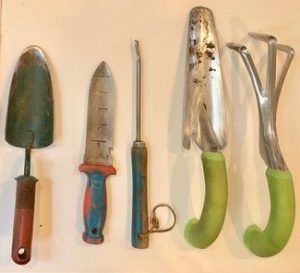
You can still gather your gardening supplies at local garden centers during COVID-19. Photo by Brenda Buchan.
To grow vegetables successfully, you will need some basic gardening supplies. This includes seeds or seedlings, fertile soil, gardening tools, and irrigation materials. If you are an avid gardener, you may already have these items at your house. But if you are new to gardening – or if you are simply missing an essential item in your everyday gardening arsenal – where do you go?
Thankfully in Florida, industries regarded as essential during these tough times include food, agriculture, and infrastructure support services. This means farmers, farm workers, farmers’ markets, produce stands, food banks, agribusiness support services, and landscaping services can continue to operate.
But for these essential services to operate safely, they still need to follow social distancing principles to protect the health of both their customers and workers. Therefore, many of our agriculture and horticulture industry personnel are finding ways to adapt. Although this involves making many adjustments, operations such as garden centers and plant nurseries are changing how they function to meet the demand of their customers while remaining safe.
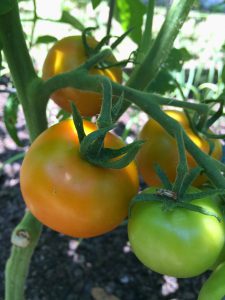
Become more self-sufficient by growing your own healthy food in your backyard. Photo by Molly Jameson.
For example, Native Nurseries in Tallahassee has temporarily closed its doors to the public, but they offer pickup and delivery options that are consistent with social distancing guidelines. Customers can either email or call the nursery and provide their contact and billing information, their purchase requests, and specify either pickup or delivery. Pickup orders are placed in a labeled designated parking space for the customer. For a fee, Native Nurseries also offers delivery of purchased items.
If you plan to make a trip to a garden center or plant nursery, call ahead or check the company’s website to learn about its social distancing policies, pickup and delivery options, and any potentially reduced hours of operation.
By continuing to support our local agriculture and horticulture businesses, we can ensure that they can weather this storm and continue to provide us with their essential services long into the future.
So, gather your supplies, stay home, and get your spring and summer vegetable garden growing!
For more information about essential services in Florida, visit: https://www.floridadisaster.org/.
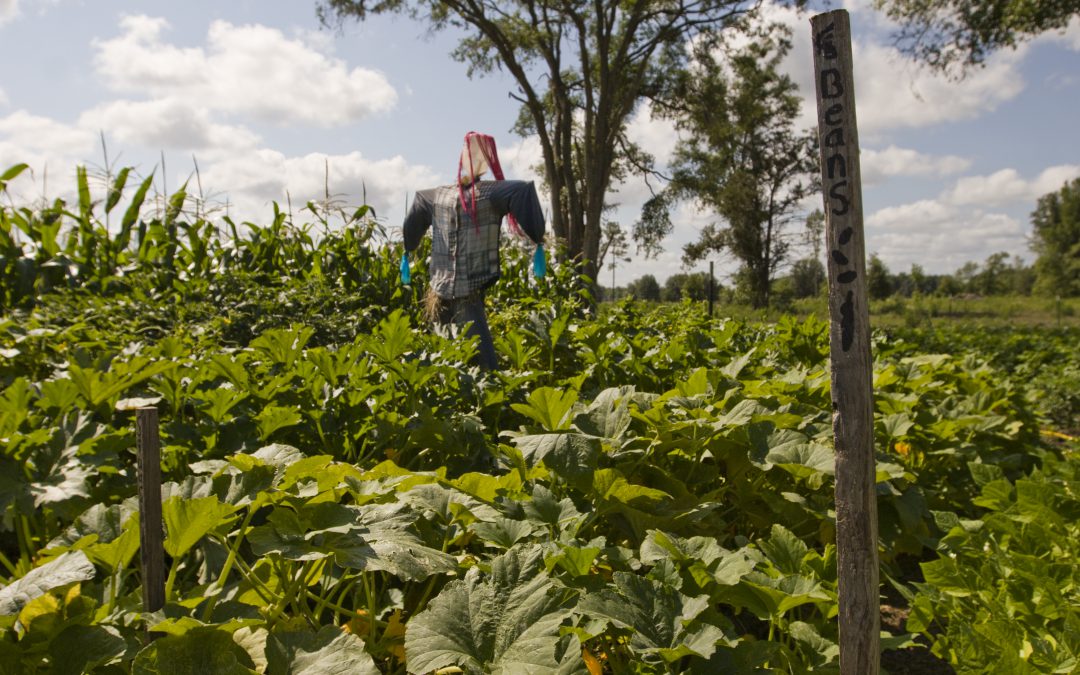
by Beth Bolles | Apr 1, 2020
Bush beans are an easy and enjoyable plant to grow in the home garden. These particular beans do not require a trellis and will be ready to start harvesting in about 50 days. Learn more about growing your own bush beans with UF IFAS Escambia County Extension In the Home Garden.
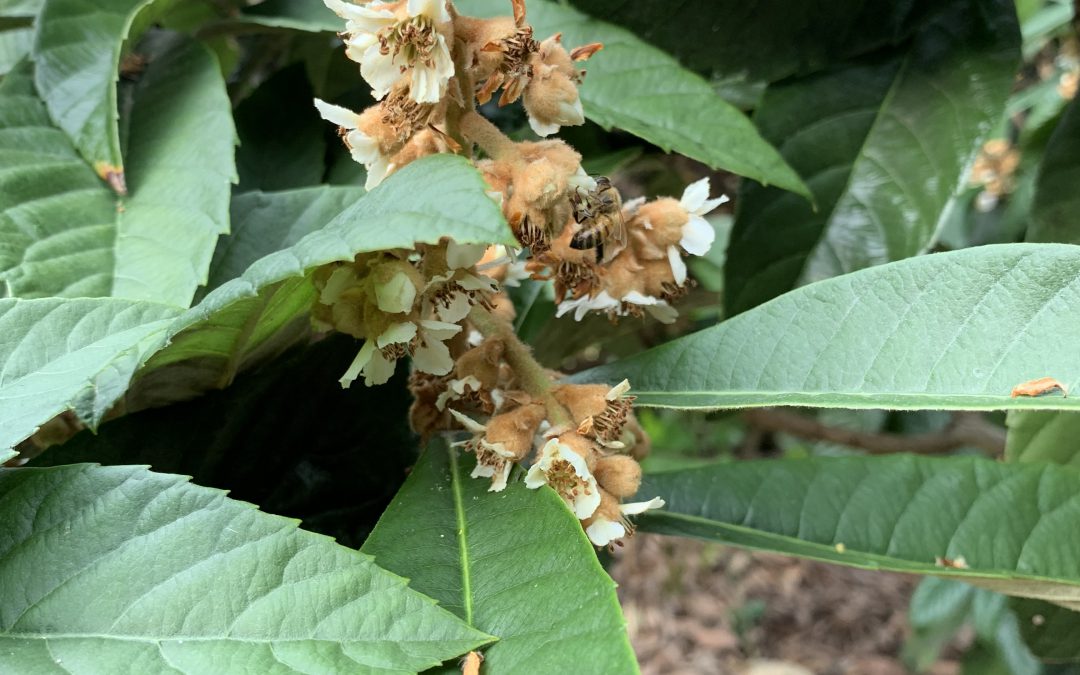
by Matt Lollar | Dec 10, 2019
Loquat trees provide nice fall color with creamy yellow buds and white flowers on their long terminal panicles. These small (20 to 35 ft. tall) evergreen trees are native to China and first appeared in Southern landscapes in the late 19th Century. They are grown commercially in subtropical and Mediterranean areas of the world and small production acreage can be found in California. They are cold tolerant down to temperatures of 8 degrees Fahrenheit, but they will drop their flowers or fruit if temperatures dip below 27 degrees Fahrenheit.
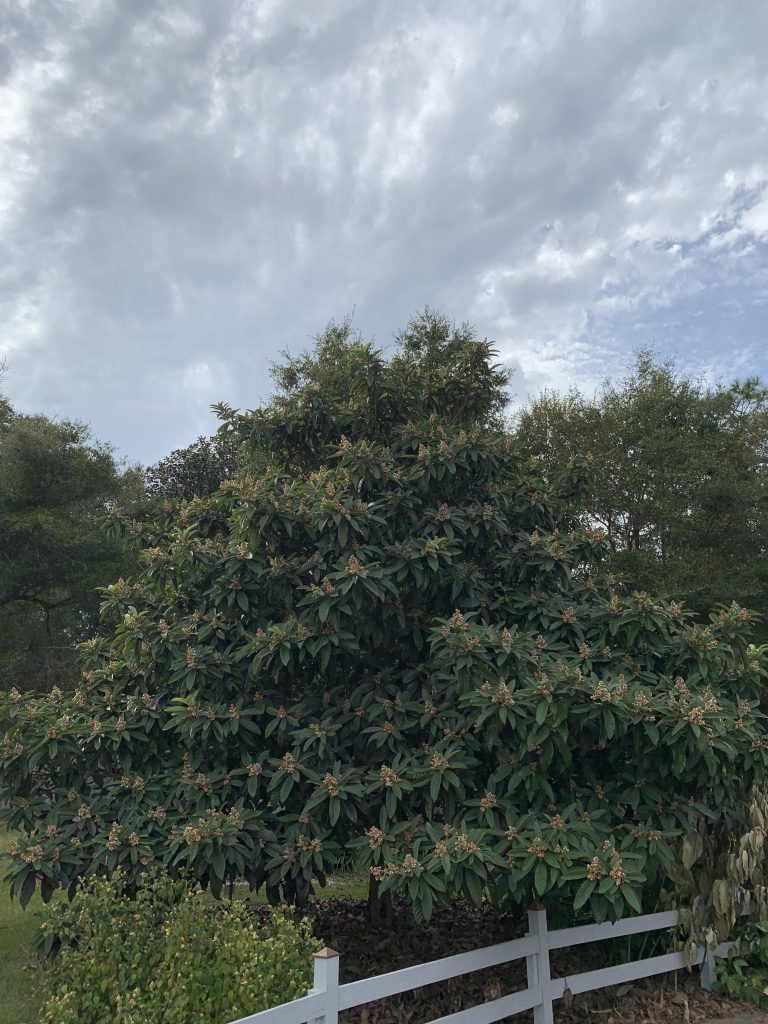
A beautiful loquat specimen at the UF/IFAS Extension at Santa Rosa County. Photo Credit: Matt Lollar, University of Florida/IFAS – Santa Rosa County
Leaves – The leaf configuration on loquat trees is classified as whorled. The leaf shape is lanceolate and the color is dark green with a nice soft brown surface underneath. These features help give the trees their tropical appearance.
Flowers – 30 to 100 flowers can be present on each terminal panicle. Individual flowers are roughly half an inch in diameter and have white petals.
Fruit – What surprises most people is that loquats are more closely related to apples and peaches than any tropical fruit. Fruit are classified as pomes and appear in clusters ranging from 4 to 30 depending on variety and fruit size. They are rounded to ovate in shape and are usually between 1.5 and 3 inches in length. Fruit are light yellow to orange in color and contain one to many seeds.

A cluster of loquat flowers/buds being pollinated by a honey bee. Photo Credit: Matt Lollar, University of Florida/IFAS – Santa Rosa County
Propagation – Loquat trees are easily propagated by seed, as you will notice as soon as your tree first bears fruit. Seedlings pop up throughout yards containing even just one loquat tree. It is important to note that the trees do not come true from seed and they go through a 6- to 8-year juvenile period before flowering and fruiting. Propagation by cuttings or air layering is more difficult but rewarding, because vegitatively-propagated trees bear fruit within two years of planting. Sometimes mature trees are top-worked (grafted at the terminal ends of branches) to produce a more desirable fruit cultivar.
Loquat trees are hardy, provide an aesthetic focal point to the landscape, and produce a tasty fruit. For more information on growing loquats and a comprehensive list of cultivars, please visit the UF EDIS Publication: Loquat Growing in the Florida Home Landscape.
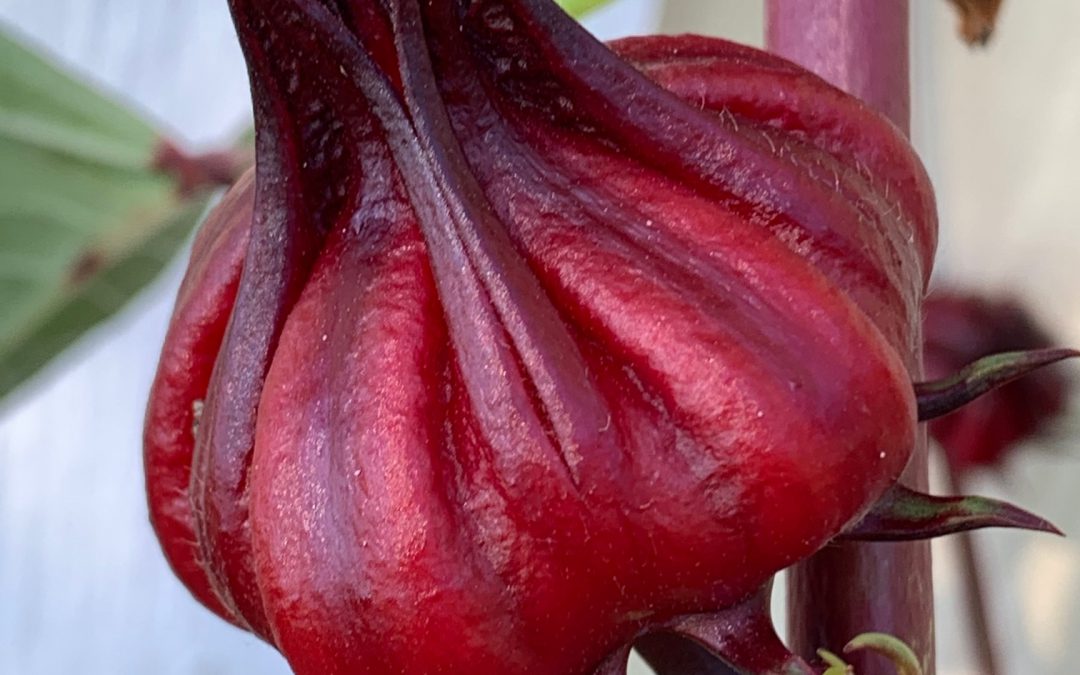
by Mary Salinas | Dec 4, 2019
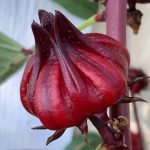
Attractive roselle fruit. Photo credit: Mary Salinas, UF/IFAS Extension.
Just before the recent cold weather I harvested seed pods from my roselle, Hibiscus sabdariffa, and made the most delicious and nutritious iced herbal tea.
You may have heard other names for this plant of Asian or African origin: bissap, red sorrel, Indian sorrel, Jamaica sorrel, Florida cranberry or jelly okra. Whatever name you call it, it has been grown in Florida since the late 1890’s.
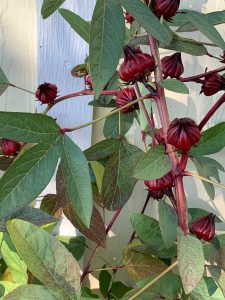
Roselle leaves and fruit. Photo credit: Mary Salinas, UF/IFAS Extension.
People around the world enjoy consuming roselle in many ways. In addition to making a beverage from the fleshy fruit, it is used to make jams, jellies, relishes, syrup and added to salads. Harvest the fruit when it is large (as in the photo) but before it gets tough. Leaves can be eaten raw in salads or cooked into dishes. Even the seeds can be made into a high protein meal or ground into a coffee substitute.
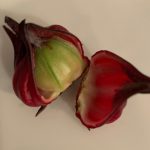
Roselle fruit showing the unripe green seedpod surrounded by the fleshy calyx. Photo credit: Mary Salinas, UF/IFAS Extension.
My lone roselle plant provided hundreds of fruits and was so easy to grow. In the spring it started as a small 3-inch seedling and by November it grew to over 4 feet tall and wide. Roselle can grow 6 to 7 feet tall. It’s not too picky on soil type if it gets plenty of sun and consistent moisture. Few pests are attracted to roselle. However, deer will eat this down to the ground, as they will any hibiscus. Since my garden is plagued by hungry deer, I placed the roselle in the back of a landscape bed with a border of plants unappetizing to the deer. Expect roselle to start blooming in mid-summer and continue through frost. Blooms only last one day before forming the equally attractive fruit.
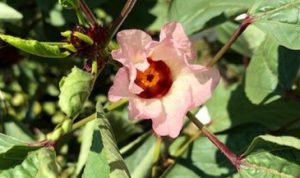
Roselle flower. Photo credit: Sally Menk, Florida Master Gardener Volunteer.
Roselle is a tropical plant and susceptible to frost in northwest Florida. To have seeds for next year, let some of the fruit stay on the branches to let the seed pods turn yellow/brown and ripen. There are also many online seed companies that carry seed.
For more information:
UF IFAS Gardening Solutions: Roselle
More on Roselle from Purdue Extension
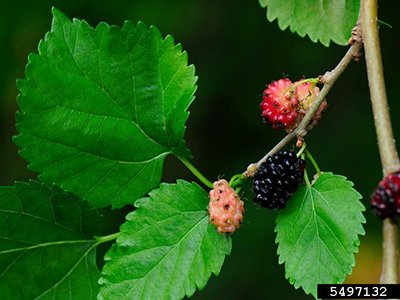
by Sheila Dunning | Dec 4, 2019
“Here we go ‘round the mulberry bush” is still sung by small children today. There are lots of different versions of the lyrics. But each usually describes a daily or weekly task list. In fact, the rhyme began in 1840 as a cadence for female prisoners exercising at the Wakefield Prison in England. There happened to be a Black Mulberry (Morus nigra) growing in the yard. Black Mulberry is a slow-growing short tree, so as a young tree it appears bushy.
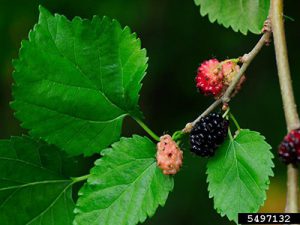 Red Mulberry (Morus rubra) is the native Florida species. It tends to grow more upright, but is still a small tree. Additionally, there are White (Morus alba) and Pakistan (Morus macroura) , as well as, many hybrid Mulberries that will grow in the Florida panhandle. White Mulberry is a fast growing tall tree that is so aggressive that it is classified as an invasive species. It can rapidly seed natural areas and become the dominant species. But, the Pakistan Mulberry is a small tree that develops a characteristic crooked, gnarled trunk and a large fruit. It can be pruned as a bush easily.
Red Mulberry (Morus rubra) is the native Florida species. It tends to grow more upright, but is still a small tree. Additionally, there are White (Morus alba) and Pakistan (Morus macroura) , as well as, many hybrid Mulberries that will grow in the Florida panhandle. White Mulberry is a fast growing tall tree that is so aggressive that it is classified as an invasive species. It can rapidly seed natural areas and become the dominant species. But, the Pakistan Mulberry is a small tree that develops a characteristic crooked, gnarled trunk and a large fruit. It can be pruned as a bush easily.
Growing the mulberry bush can add a unique winter feature to the landscape while producing food for the birds. Yet, the plant is short enough that the fruit can be harvested without having to shake the tree and gather up the fruit from the ground before the birds get all the berries.
Mulberries are self-pollinating and only require about 400 chill hours. A chill hour is each hour that the temperature remain between 32 and 45 degrees Fahrenheit. After 400 cumulative hours the plant is able to flower. The fruit matures in the late spring to early summer. The birds will be sure to notify everyone when it’s time. Pakistan Mulberry can produce 4 inch long berries.
Mulberries will perform well if planted this winter. Plan on pruning them back each year if the bush effect is desired. It can take a year or two to get fully rooted. Don’t be surprised to see some fruit drop off prematurely as the tree/bush gets established. Also, pay attention to where the mulberry is installed. Windy spots will knock off fruit. What birds eat, they deposit. Mulberries will stain the surfaces they land on. If the fruit is walked through, the staining can be moved to indoor surfaces.
When picking fruit don’t forget the gloves unless dark stained fingers is the new look you’re trying to create.
For more information on mulberries: http://gardeningsolutions.ifas.ufl.edu/plants/trees-and-shrubs/trees/mulberry.html

by Matt Lollar | Oct 8, 2019
Last week at the Panhandle Fruit and Vegetable Conference, Dr. Ali Sarkhosh presented on growing pomegranate in Florida. The pomegranate (Punica granatum) is native to central Asia. The fruit made its way to North America in the 16th century. Given their origin, it makes sense that fruit quality is best in regions with cool winters and hot, dry summers (Mediterranean climate). In the United States, the majority of pomegranates are grown in California. However, the University of Florida, with the help of Dr. Sarkhosh, is conducting research trials to find out which varieties do best in our state.
In the wild, pomegranate plants are dense, bushy shrubs growing between 6-12 feet tall with thorny branches. In the garden, they can be trained as small single trunk trees from 12-20 feet tall or as slightly shorter multi-trunk (3 to 5 trunks) trees. Pomegranate plants have beautiful flowers and can be utilized as ornamentals that also bear fruit. In fact, there are a number of varieties on the market for their aesthetics alone. Pomegranate leaves are glossy, dark green, and small. Blooms range from orange to red (about 2 inches in diameter) with crinkled petals and lots of stamens. The fruit can be yellow, deep red, or any color in between depending on variety. The fruit are round with a diameter from 2 to 5 inches.
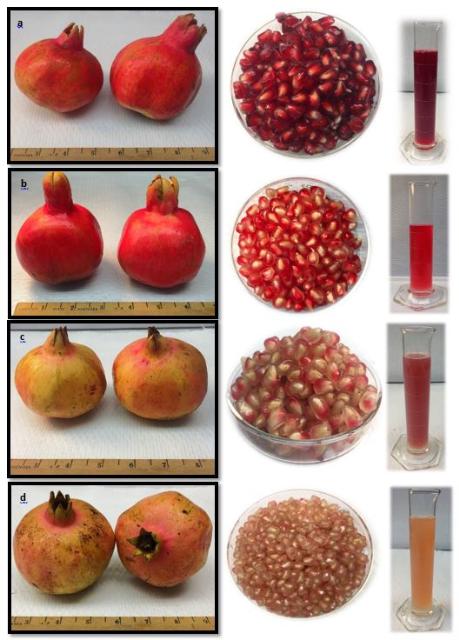
Fruit, aril, and juice characteristics of four pomegranate cultivars grown in Florida; fruit harvested in August 2018. a) ‘Vkusnyi’, b) ‘Crab’, c) ‘Mack Glass’, d) ‘Ever Sweet’. Photo Credit: Ali Sarkhosh, University of Florida/IFAS
A common commercial variety, ‘Wonderful’, is widely grown in California but does not perform well in Florida’s hot and humid climate. Cultivars that have performed well in Florida include: ‘Vkusnyi’; ‘Crab’; ‘Mack Glass’; and ‘Ever Sweet’. Pomegranates are adapted to many soil types from sands to clays, however yields are lower on sandy soils and fruit color is poor on clay soils. They produce best on well-drained soils with a pH range from 5.5 to 7.0. The plants should be irrigated every 7 to 10 days if a significant rain event doesn’t occur. Flavor and fruit quality are increased when irrigation is gradually reduced during fruit maturation. Pomegranates are tolerant of some flooding, but sudden changes to irrigation amounts or timing may cause fruit to split.
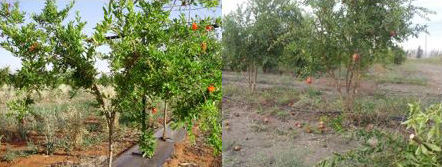
Two pomegranate training systems: single trunk on the left and multi-trunk on the right. Photo Credit: Ali Sarkhosh, University of Florida/IFAS
Pomegranates establish best when planted in late winter or early spring (February – March). If you plan to grow them as a hedge (shrub form), space plants 6 to 9 feet apart to allow for suckers to fill the void between plants. If you plan to plant a single tree or a few trees then space the plants at least 15 feet apart. If a tree form is desired, then suckers will need to be removed frequently. Some fruit will need to be thinned each year to reduce the chances of branches breaking from heavy fruit weight.
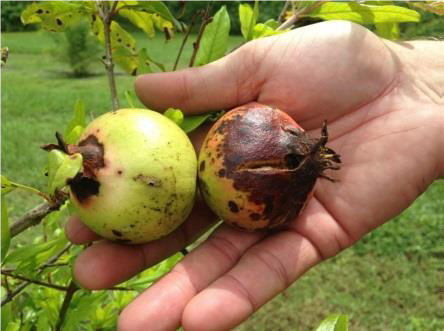
Anthracnose caused by Colletotrichum sp. to pomegranate fruit. Photo Credit: Gary Vallad, University of Florida/IFAS
Anthracnose is the most common disease of pomegranates. Symptoms include small, circular, reddish-brown spots (0.25 inch diameter) on leaves, stems, flowers, and fruit. Copper fungicide applications can greatly reduce disease damage. Common insects include scales and mites. Sulfur dust can be used for mite control and horticultural oil can be used to control scales.


















